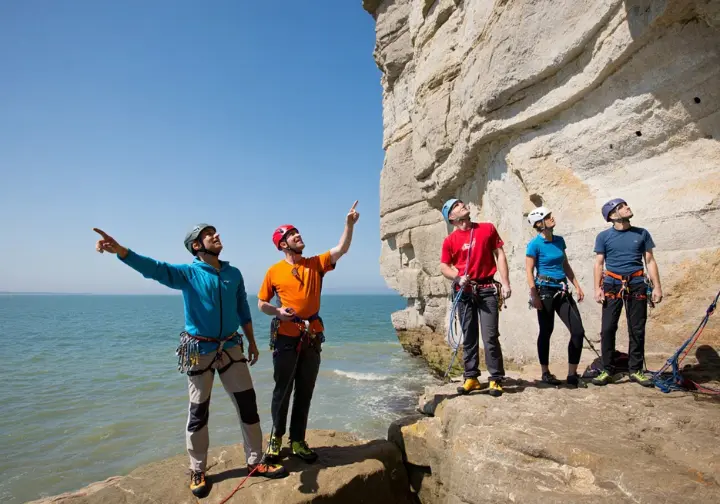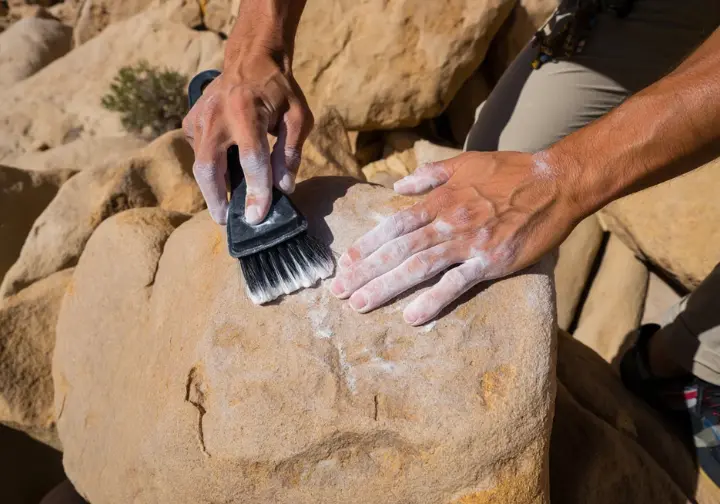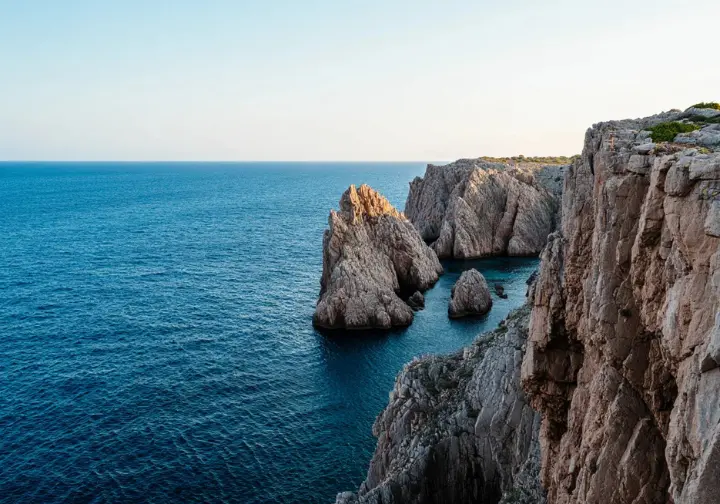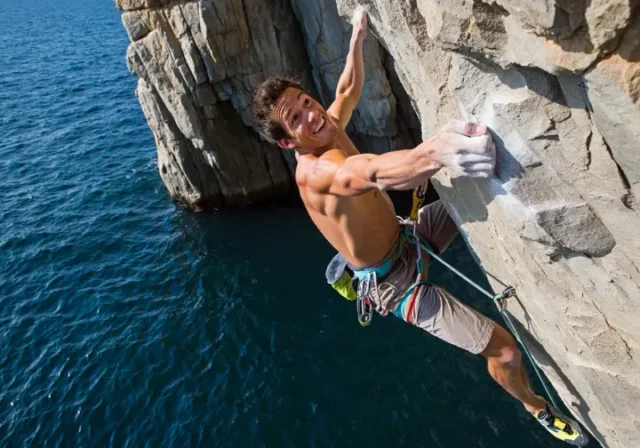In this article
Finding information about certain figures in climbing history can sometimes feel like navigating a tricky route. This is certainly true for Damian Cook, a pivotal climber in the UK’s Deep Water Soloing (DWS) scene. His story often gets tangled with that of a similarly named athlete, making it hard to grasp his specific contributions.
This piece aims to set the record straight, focusing solely on Damian Cook, the Dorset climber whose passion helped shape a unique climbing style. We’ll explore his roots, his crucial role in developing UK DWS, his notable climbs, and the legacy he left behind after his untimely death. Join us as we piece together the path of this influential British climber.
Clearing the Crux: Disambiguating Damian Cook Climber

Before we delve into the specifics of his life and achievements, it’s essential to distinguish the climber from another public figure who shares a similar name, ensuring we’re following the right path.
Identifying the Correct Person
First, let’s firmly establish who we’re discussing. We mean Damian Cook, the British rock climber prominent in the 1990s and early 2000s. He is distinctly different from Damien Cook, the contemporary Australian rugby league player. The nearly identical names frequently lead to confusion online, so clear identification is our first foothold.
Our focus remains exclusively on the UK climber, Damian Cook. He was renowned for his pioneering efforts in Deep Water Soloing, particularly along the striking Dorset coast. Before his tragic death in 2004, he was a deeply respected member of the British climbing community. Understanding his place in UK climbing history is key.
For absolute clarity, Damien Cook (note the ‘e’) is a professional Australian rugby league player, born in 1991. He’s known for his career with teams like the South Sydney Rabbitohs and playing internationally. His athletic profile often dominates search results, obscuring the climber‘s story.
The key differences are stark: nationality (UK vs. Australia), profession (Climber vs. Rugby Player), era (1990s-2004 vs. 2013-Present), and primary association (Dorset DWS vs. NRL Rugby). Damian Cook the climber is deceased, while Damien Cook the athlete is currently active.
The high visibility of the rugby player presents a search result challenge. It often overshadows details about Damian Cook the climber. This makes dedicated biographical content vital for preserving access to the DWS pioneer‘s legacy and helping users find the specific climber they seek.
Damian Cook vs Damien Cook
Let’s solidify the distinctions. A simple yet critical point is the name spelling: Damian (climber) uses an ‘a’, while Damien (rugby player) uses an ‘e’. This small detail is a primary identifier when sorting through information.
Their fields couldn’t be more different. Damian Cook was a British climber, deeply embedded in the Dorset scene and known for Deep Water Soloing. Damien Cook is an Australian athlete excelling in professional rugby league. Their national contexts and sports are entirely separate worlds.
Their active periods also diverge clearly. Damian Cook the climber made his mark in the 1990s and early 2000s. Damien Cook, the rugby player, started his professional journey around 2013 and continues today. This timeline helps separate their careers and contributions accurately.
Defining achievements further highlight their distinct paths. The climber, Damian Cook, is remembered for pioneering UK DWS, establishing routes, and co-authoring the seminal “Into the Blue” guidebook. The rugby player is known for his NRL career and representative honours. Their legacies occupy vastly different arenas.
A definitive difference is their life status. Damian Cook, the climber, sadly passed away in April 2004. Damien Cook, the rugby player, is alive and active in his sport. This fact is fundamental for biographical accuracy.
Profile of a Pioneer: Getting to Know Damian Cook

Understanding the person behind the pioneering efforts gives depth to their achievements. Damian Cook wasn’t just a name associated with DWS; he was an integral part of the climbing community.
Roots in Dorset Climbing
Damian Cook was a well-known and popular figure within the dynamic Dorset climbing scene during the 1990s. Alongside his brother, Joff Cook, he was a key player in developing the area’s potential, especially in the emerging discipline of Deep Water Soloing. His deep connection to this regional community shaped his early climbing experiences.
Sources consistently refer to him as a “popular Dorset climber” and a “well-known and highly-respected figure”. This respect came from his climbing ability and his contributions to the community’s growth and spirit. His reputation speaks volumes about his positive influence among fellow climbers.
Damian was often mentioned with his brother, Joff, forming the “Cook brothers” duo active in Dorset climbing. This partnership suggests a strong collaborative approach to their explorations and route development. Their combined efforts left a significant mark on the local climbing landscape.
His time in the Dorset scene coincided directly with the rise of DWS in the UK. He was part of the core group actively scaling cliffs above the sea, identifying potential lines, and pushing the boundaries of this adventurous climbing style. This early engagement placed him at the forefront of DWS development.
Cook’s immersion in the Dorset climbing culture provided the bedrock for his later pioneering work. The relationships formed and experience gained were instrumental in projects like the first DWS guidebook. His local expertise proved invaluable to the climbing world.
Personality and Family
While detailed personal accounts are scarce, tributes paint a picture of Damian Cook. One climber simply recalled him as a “lovely chap.” Another tribute noted his adventurous spirit shone through in photos and writing, suggesting boldness and grace. These glimpses portray an approachable and spirited individual.
His work, especially the “Into the Blue” guidebook, was cited as inspirational by fellow climbing enthusiasts. Even those who didn’t know him personally felt the impact of his contributions, showing his ability to motivate others through pioneering efforts and documentation. His influence clearly extended beyond his immediate circle.
At the time of his passing in 2004, Damian Cook was married and had a young family. This personal detail adds a layer of tragedy to his story, highlighting the human cost beyond the loss felt by the climbing community. It reminds us of the life behind the climbing persona.
The consistent use of terms like “popular,” “well-respected,” “legend,” and “inspirational” in tributes underscores his significant standing. These descriptions reflect a legacy built on technical skill and positive personal influence. His role was more than just climbing rocks; he helped shape the climbing culture.
His active role in the DWS development team and co-authorship of a foundational guidebook suggest he was a key motivator. He wasn’t just participating; he was helping shape the discipline and share knowledge, indicating leadership and commitment to the community’s growth. Have you ever been inspired by someone’s dedication within your own pursuits?
UK DWS Development Role: Charting New Waters

Damian Cook wasn’t just present during the rise of UK Deep Water Soloing; he was one of the key navigators charting its course, particularly through collaborative efforts and landmark documentation.
The UK DWS Explosion
The 1990s witnessed a significant surge—an “explosion”—in the popularity and development of Deep Water Soloing (DWS) in the UK. Dorset’s limestone cliffs became the epicenter. While not entirely new, this decade saw a focused effort to explore and establish routes, pushing DWS into the British climbing mainstream. Damian Cook was right there, at the heart of this pivotal era.
Dorset, on the southern coast, became the primary hotspot for this burgeoning activity. The area’s unique geology provided the ideal canvas for climbers like Cook to explore climbing above the sea without ropes. This geographical focus was central to the UK’s DWS narrative.
While the ’90s saw rapid growth, earlier DWS activities laid some groundwork, like Nick Buckley’s 1983 solo of “The Conger”. The ’90s team, including Cook, built upon these precedents, systematically exploring and documenting potential on a much larger scale. This shows the discipline’s evolution.
UK DWS developed somewhat parallel to the Mallorcan “Psicobloc” scene. It represented the British interpretation of rope-free climbing above water. While sharing the core concept, the UK scene had its own distinct character, locations, and pioneers like Damian Cook.
A key feature of this era was its collaborative spirit. The rapid growth wasn’t one person’s effort but a collective push by a dedicated group exploring, establishing routes, and defining the ethics of the style. This teamwork was fundamental.
Core Development Team Member
Damian Cook was explicitly named as part of the core group driving DWS development in Dorset during the 1990s. This team included his brother Joff Cook, Mike Robertson, Steve Taylor, and Pete Oxley. Recognizing this collective is vital to understanding the collaborative nature of early UK DWS. Many pioneering efforts rely on such group dynamics, don’t they?
This group worked in tandem, systematically exploring the Dorset coastline to identify potential DWS cliffs and routes. Their combined efforts involved scouting, assessing feasibility and safety, and making the first climbed ascents of many classic lines. Teamwork significantly accelerated development.
Beyond just climbing, Cook and the team were instrumental in establishing the style, ethics, and approach to DWS in the UK. This included developing grading systems accounting for factors beyond technical difficulty, like the seriousness (‘S’ grade) of a fall. Their work shaped how DWS was practiced.
Visual confirmation exists too. A photograph in a historical article explicitly labels Cook and his collaborators as “The original UK DWS team”. This reinforces his central position within this influential group, providing a tangible link to the key figures.
The collective knowledge gained by this core team formed the essential groundwork for the “Into the Blue” guidebook. Their practical experience directly translated into the information shared with the wider community. Cook‘s role on the team was thus foundational to the guidebook’s creation.
“Into the Blue” Guidebook
Published by the Climbers’ Club in 1996, “Into the Blue: A guide to Deep Water Soloing in Dorset” was a landmark achievement. It holds the distinction of being the world’s first guidebook dedicated specifically to DWS. Damian Cook was a key co-author alongside Jonathan (Joff) Cook, Mike Robertson, and Steve Taylor. This publication marked a major milestone.
The guidebook’s significance lies in codifying DWS in the UK. It documented routes, locations, and crucially, introduced an evolved grading system, likely including the ‘S’ scale (S0-S3) for seriousness. It formalized DWS as a distinct climbing discipline, moving beyond purely technical grades.
“Into the Blue” proposed “a whole new approach to climbing in Britain”. It captured the adventurous spirit of DWS and presented it accessibly, encouraging others. Its impact was described as “gobsmacking” and inspirational upon release. It was a true seminal climbing resource.
The publication marked DWS’s transition from an informal activity to a documented discipline accessible to the broader community. Cook’s co-authorship placed him centrally in this vital process of knowledge sharing. This accessibility spurred further interest. A common mistake for new climbers exploring guidebooks is underestimating the non-technical grades like ‘S’ ratings, which convey crucial risk information.
The multi-author nature reflects the collaborative spirit of the early UK DWS scene. It was a collective effort to capture and share knowledge gained through shared exploration. Cook‘s contribution was integral to this joint documentation, laying down foundational climbing skills for future deep water climbers.
Climbing Feats and Legacy: Reaching New Heights

Damian Cook‘s impact wasn’t confined to guidebooks; his personal climbing achievements and the enduring respect he commanded cemented his legacy as a talented climber.
Notable First Ascents
Damian Cook was recognized by peers for achieving “good first ascents,” indicating high ability and a drive to establish new routes. Making a first ascent requires vision, exploration, and skill. This recognition speaks to his technical proficiency and exploratory mindset.
One specific first climbed route attributed to Damian Cook is “Frazzled” at Wallsend, a Dorset sea cliff. Naming this specific climb provides concrete evidence of his contributions beyond DWS pioneering. Wallsend remains a known Dorset venue for various climbing styles.
While “Frazzled” is named, it’s highly likely Cook established other first ascents, particularly DWS routes during the 1990s development phase. Available sources may not capture his complete resume, suggesting undocumented achievements exist. His known activity level points towards more incredible climbs.
His brother, Joff Cook, is also credited with significant Dorset first ascents, such as “Captain Bastard Got There First” (F6a+) at Lulworth in 1991. This highlights the Cook brothers‘ collective impact on developing new climbs in the region, enriching the Dorset portfolio.
Many of his first ascents were likely ground-breaking climbs within DWS, established during the core development phase. These ascents mapped the DWS potential of the Dorset coast and formed the basis for the “Into the Blue” guidebook, directly fueling the DWS movement.
International Bouldering Pioneer
Damian Cook‘s influence extended beyond UK DWS. Later in his climbing life, he dedicated significant effort to pioneering bouldering internationally, specifically developing new areas in the Arabian Peninsula. This shows a broader passion for exploration.
He undertook major development in the Musandam Peninsula, accessible from Dibba (UAE/Oman border). He explored and established problems in Wadi Khab Al Shamis, a vast field of water-washed limestone boulders, opening a significant new destination for international climbers.
The extensive boulder field he developed is now known posthumously as “Damian’s Boulders”. This area contains over 20 distinct boulders with more than 50 established problems, standing as a major regional venue. What a way to be remembered by fellow climbers, right?
His work highlighted the significant, previously untapped bouldering potential of the Middle East. “Damian’s Boulders” is considered potentially the most extensive bouldering area there, showcasing the scale of his discovery and putting the region on the climbing map.
The naming serves as a powerful tribute to his pioneering spirit. Dedicating a major climbing area is a significant honor, ensuring his legacy is physically tied to the landscape he helped develop. It’s a lasting memorial for the Damian Cook climber.
Enduring Climbing Legacy
Damian Cook is remembered and referred to as a “Dorset legend”. This title reflects the immense respect he garnered and his foundational impact, particularly concerning DWS. It signifies his iconic status among local climbers.
Consistently described as a “highly-respected figure,” his reputation extended throughout the UK climbing community and beyond. This respect was built on achievements, collaborative spirit, and likely his personality. His standing reflects the positive mark he left.
His work, especially “Into the Blue” and his adventurous approach, continues to be cited as inspirational. He motivated others to explore DWS and push boundaries, demonstrating a legacy that encourages participation and exploration. Inspired climbers often follow such paths.
The naming of “Damian’s Boulders” provides a significant, tangible memorial. This act ensures his name and contributions to international bouldering development are permanently recognized. Such dedications mark figures of major importance.
His pioneering efforts in UK DWS laid a crucial foundation. Later DWS guides and the discipline’s continued popularity build upon the groundwork established by Cook and his collaborators. His work enabled the growth of responsible climbing practices within DWS.
Tragic Death and Impact: A Sobering Reminder

Every adventure carries inherent risks, and Damian Cook‘s story includes a tragic final chapter that profoundly impacted the climbing community and awareness around DWS safety.
Circumstances of the Accident
Damian Cook tragically died on Wednesday, April 28th, 2004. The accident occurred while he was Deep Water Soloing at Porto Cristo, Mallorca, Spain – a world-renowned DWS destination. Many climbers dream of visiting such spots.
He was engaged in DWS and was climbing alone at the time. Reports indicate he drowned, suggesting an inability to exit the water after a fall or being overcome by sea conditions. This highlights the vulnerability even on seemingly straightforward climbs.
Sources mention the sea conditions were “challenging.” One account raises the possibility of strong currents playing a role, potentially sweeping him away. This underscores objective environmental hazards beyond the climb itself. Misjudging conditions is a common pitfall for even seasoned climbers.
The fact he was soloing alone is a significant detail. Solo climbing, especially DWS, increases risk immensely, as no immediate assistance is available. This aspect likely contributed to the tragic outcome.
The accident involved a highly experienced DWS practitioner. It underscores the inherent risks present in DWS, regardless of skill, particularly when combined with challenging conditions and solo climbing. It served as a stark reminder of vulnerability. Even a proficient climber must respect the environment.
Community Shock and Reflection
News of Damian Cook‘s death sent shockwaves through the climbing community. It was described as “extremely sad news” that deeply affected many. Tributes poured in, reflecting the high esteem in which Damian was held. The loss was felt widely.
His death served as a stark, sobering reminder of DWS dangers. The fact a pioneer could die practicing the discipline highlighted that DWS “could hold fatal consequences,” prompting reflection on risk assessment. It brought potential dangers into sharp focus for aspiring climbers and veterans alike.
The accident likely spurred conversations about DWS safety protocols. Factors like assessing sea conditions, the risks of soloing versus climbing with partners, and safety measures would have been re-evaluated. Learning how to properly assess risk is something every climber discovers eventually.
There’s a poignant irony: a key figure who helped develop and popularize UK DWS ultimately lost his life to its dangers. His story became intrinsically linked to the safety narrative surrounding the climbing style he championed. Damian meant so much to the DWS world.
Cook‘s accident reinforces the need for caution and thorough assessment. It emphasizes that DWS demands respect for the environment, even for the most experienced. His story is a crucial, albeit tragic, lesson in risk management for all climbers.
Remembering Damian Cook Climber: Key Takeaways
As we reach the summit of this exploration, let’s consolidate the key points about Damian Cook, the climber, ensuring his contributions remain clear.
- Disambiguation is Key: Damian Cook, the UK DWS pioneer (d. 2004), is distinct from Damien Cook, the Australian rugby player. Correct identification is vital.
- DWS Pioneer: Cook was central to the 1990s UK DWS explosion, co-authoring the first DWS guidebook, “Into the Blue,” and establishing the discipline in Dorset. His initial climbs in this style paved the way.
- Broader Contributions: His impact included UK first ascents like “Frazzled” and significant international bouldering development, notably “Damian’s Boulders” in the Middle East. His passionate climbs weren’t limited to one style.
- Legacy and Risk: Remembered as a respected “Dorset legend,” his tragic death while soloing in Mallorca serves as a permanent reminder of DWS risks, influencing safety awareness. The final climb holds lessons.
- Explore Further: Interested readers can delve into linked sources like UKClimbing archives for deeper insights into Cook‘s era.
- Visit Related Areas: Explore information about Dorset DWS or “Damian’s Boulders” online via UKC Logbooks or Mountain Project to appreciate the physical context.
- Share His Story: Help preserve the memory of Damian Cook, the climber, ensuring his specific contributions are accurately remembered.
Frequently Asked Questions
Who was Damian Cook the climber? >
How is Damian Cook different from Damien Cook? >
What were Damian Cook’s main contributions to climbing? >
How did Damian Cook die? >
We are a participant in the Amazon Services LLC Associates Program, an affiliate advertising program designed to provide a means for sites to earn advertising fees by advertising and linking to Amazon.com. As an Amazon Associate I earn from qualifying purchases. We also participate in other affiliate programs. The information provided on this website is provided for entertainment purposes only. We make no representations or warranties of any kind, expressed or implied, about the completeness, accuracy, adequacy, legality, usefulness, reliability, suitability, or availability of the information, or about anything else. Any reliance you place on the information is therefore strictly at your own risk. Additional terms are found in the terms of service.










